Daohan Su
Two Sides of the Same Optimization Coin: Model Degradation and Representation Collapse in Graph Foundation Models
Sep 11, 2025Abstract:Graph foundation models, inspired by the success of LLMs, are designed to learn the optimal embedding from multi-domain TAGs for the downstream cross-task generalization capability. During our investigation, graph VQ-MAE stands out among the increasingly diverse landscape of GFM architectures. This is attributed to its ability to jointly encode topology and textual attributes from multiple domains into discrete embedding spaces with clear semantic boundaries. Despite its potential, domain generalization conflicts cause imperceptible pitfalls. In this paper, we instantiate two of them, and they are just like two sides of the same GFM optimization coin - Side 1 Model Degradation: The encoder and codebook fail to capture the diversity of inputs; Side 2 Representation Collapse: The hidden embedding and codebook vector fail to preserve semantic separability due to constraints from narrow representation subspaces. These two pitfalls (sides) collectively impair the decoder and generate the low-quality reconstructed supervision, causing the GFM optimization dilemma during pre-training (coin). Through empirical investigation, we attribute the above challenges to Information Bottleneck and Regularization Deficit. To address them, we propose MoT (Mixture-of-Tinkers) - (1) Information Tinker for Two Pitfalls, which utilizes an edge-wise semantic fusion strategy and a mixture-of-codebooks with domain-aware routing to improve information capacity. (2) Regularization Tinker for Optimization Coin, which utilizes two additional regularizations to further improve gradient supervision in our proposed Information Tinker. Notably, as a flexible architecture, MoT adheres to the scaling laws of GFM, offering a controllable model scale. Compared to SOTA baselines, experiments on 22 datasets across 6 domains demonstrate that MoT achieves significant improvements in supervised, few-shot, and zero-shot scenarios.
Towards Unbiased Federated Graph Learning: Label and Topology Perspectives
Apr 14, 2025Abstract:Federated Graph Learning (FGL) enables privacy-preserving, distributed training of graph neural networks without sharing raw data. Among its approaches, subgraph-FL has become the dominant paradigm, with most work focused on improving overall node classification accuracy. However, these methods often overlook fairness due to the complexity of node features, labels, and graph structures. In particular, they perform poorly on nodes with disadvantaged properties, such as being in the minority class within subgraphs or having heterophilous connections (neighbors with dissimilar labels or misleading features). This reveals a critical issue: high accuracy can mask degraded performance on structurally or semantically marginalized nodes. To address this, we advocate for two fairness goals: (1) improving representation of minority class nodes for class-wise fairness and (2) mitigating topological bias from heterophilous connections for topology-aware fairness. We propose FairFGL, a novel framework that enhances fairness through fine-grained graph mining and collaborative learning. On the client side, the History-Preserving Module prevents overfitting to dominant local classes, while the Majority Alignment Module refines representations of heterophilous majority-class nodes. The Gradient Modification Module transfers minority-class knowledge from structurally favorable clients to improve fairness. On the server side, FairFGL uploads only the most influenced subset of parameters to reduce communication costs and better reflect local distributions. A cluster-based aggregation strategy reconciles conflicting updates and curbs global majority dominance . Extensive evaluations on eight benchmarks show FairFGL significantly improves minority-group performance , achieving up to a 22.62 percent Macro-F1 gain while enhancing convergence over state-of-the-art baselines.
Toward Effective Digraph Representation Learning: A Magnetic Adaptive Propagation based Approach
Jan 21, 2025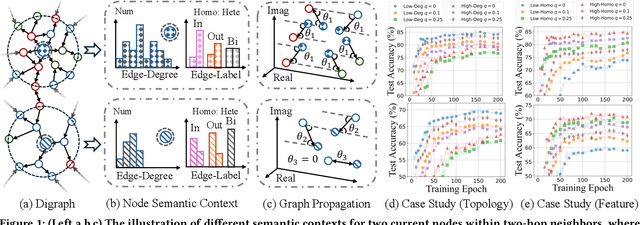
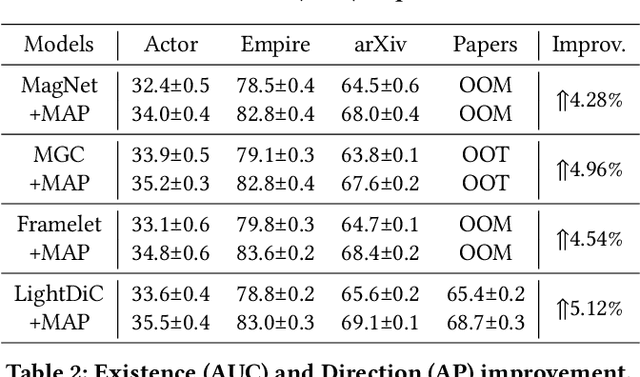
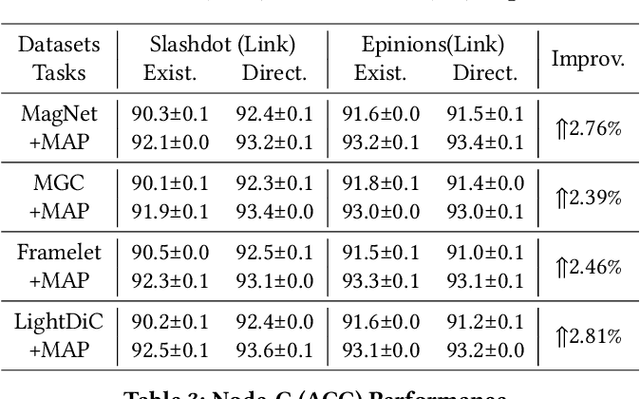
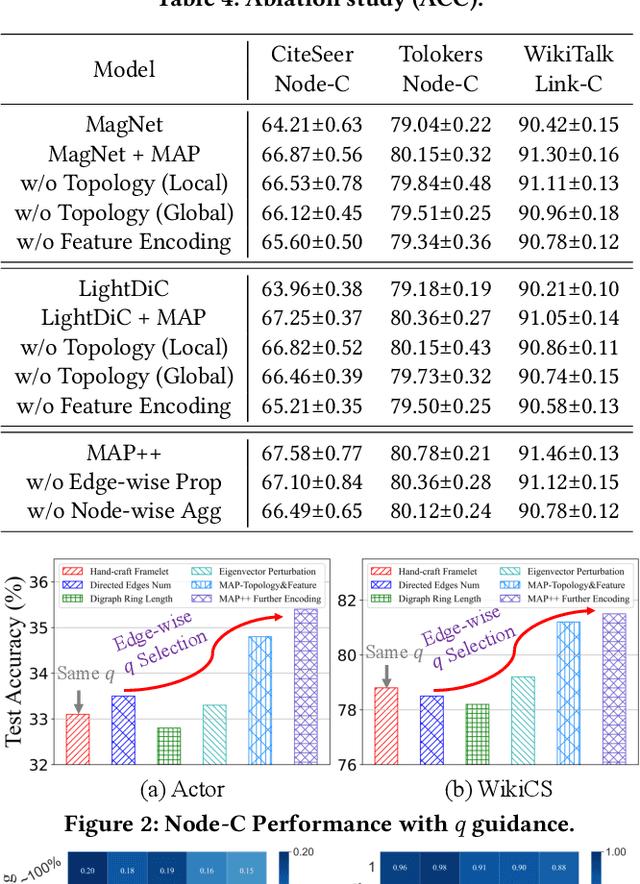
Abstract:The $q$-parameterized magnetic Laplacian serves as the foundation of directed graph (digraph) convolution, enabling this kind of digraph neural network (MagDG) to encode node features and structural insights by complex-domain message passing. As a generalization of undirected methods, MagDG shows superior capability in modeling intricate web-scale topology. Despite the great success achieved by existing MagDGs, limitations still exist: (1) Hand-crafted $q$: The performance of MagDGs depends on selecting an appropriate $q$-parameter to construct suitable graph propagation equations in the complex domain. This parameter tuning, driven by downstream tasks, limits model flexibility and significantly increases manual effort. (2) Coarse Message Passing: Most approaches treat all nodes with the same complex-domain propagation and aggregation rules, neglecting their unique digraph contexts. This oversight results in sub-optimal performance. To address the above issues, we propose two key techniques: (1) MAP is crafted to be a plug-and-play complex-domain propagation optimization strategy in the context of digraph learning, enabling seamless integration into any MagDG to improve predictions while enjoying high running efficiency. (2) MAP++ is a new digraph learning framework, further incorporating a learnable mechanism to achieve adaptively edge-wise propagation and node-wise aggregation in the complex domain for better performance. Extensive experiments on 12 datasets demonstrate that MAP enjoys flexibility for it can be incorporated with any MagDG, and scalability as it can deal with web-scale digraphs. MAP++ achieves SOTA predictive performance on 4 different downstream tasks.
Towards Data-centric Machine Learning on Directed Graphs: a Survey
Nov 28, 2024



Abstract:In recent years, Graph Neural Networks (GNNs) have made significant advances in processing structured data. However, most of them primarily adopted a model-centric approach, which simplifies graphs by converting it into undirected formats and emphasizes model designs. This approach is inherently constrained in real-world applications due to inevitable information loss in simple undirected graphs and data-driven model optimization dilemmas associated with exceeding the upper bounds of representational capacity. As a result, there has been a shift toward data-centric methods that prioritize improving graph quality and representation. Specifically, various types of graphs can be derived from naturally structured data, including heterogeneous graphs, hypergraphs, and directed graphs. Among these, directed graphs offer distinct advantages in topological systems by modeling causal relationships, and directed GNNs have been extensively studied in recent years. However, a comprehensive survey of this emerging topic is still lacking. Therefore, we aim to provide a comprehensive review of directed graph learning, with a particular focus on a data-centric perspective. Specifically, we first introduce a novel taxonomy for existing studies. Subsequently, we re-examine these methods from the data-centric perspective, with an emphasis on understanding and improving data representation. It demonstrates that a deep understanding of directed graphs and its quality plays a crucial role in model performance. Additionally, we explore the diverse applications of directed GNNs across 10+ domains, highlighting their broad applicability. Finally, we identify key opportunities and challenges within the field, offering insights that can guide future research and development in directed graph learning.
DiRW: Path-Aware Digraph Learning for Heterophily
Oct 14, 2024Abstract:Recently, graph neural network (GNN) has emerged as a powerful representation learning tool for graph-structured data. However, most approaches are tailored for undirected graphs, neglecting the abundant information embedded in the edges of directed graphs (digraphs). In fact, digraphs are widely applied in the real world (e.g., social networks and recommendations) and are also confirmed to offer a new perspective for addressing topological heterophily challenges (i.e., connected nodes have complex patterns of feature distribution or labels). Despite recent significant advancements in DiGNNs, existing spatial- and spectral-based methods have inherent limitations due to the complex learning mechanisms and reliance on high-quality topology, leading to low efficiency and unstable performance. To address these issues, we propose Directed Random Walk (DiRW), which can be viewed as a plug-and-play strategy or an innovative neural architecture that provides a guidance or new learning paradigm for most spatial-based methods or digraphs. Specifically, DiRW incorporates a direction-aware path sampler optimized from the perspectives of walk probability, length, and number in a weight-free manner by considering node profiles and topological structure. Building upon this, DiRW utilizes a node-wise learnable path aggregator for generalized messages obtained by our proposed adaptive walkers to represent the current node. Extensive experiments on 9 datasets demonstrate that DiRW: (1) enhances most spatial-based methods as a plug-and-play strategy; (2) achieves SOTA performance as a new digraph learning paradigm.
Rethinking Node-wise Propagation for Large-scale Graph Learning
Feb 09, 2024Abstract:Scalable graph neural networks (GNNs) have emerged as a promising technique, which exhibits superior predictive performance and high running efficiency across numerous large-scale graph-based web applications. However, (i) Most scalable GNNs tend to treat all nodes in graphs with the same propagation rules, neglecting their topological uniqueness; (ii) Existing node-wise propagation optimization strategies are insufficient on web-scale graphs with intricate topology, where a full portrayal of nodes' local properties is required. Intuitively, different nodes in web-scale graphs possess distinct topological roles, and therefore propagating them indiscriminately or neglect local contexts may compromise the quality of node representations. This intricate topology in web-scale graphs cannot be matched by small-scale scenarios. To address the above issues, we propose \textbf{A}daptive \textbf{T}opology-aware \textbf{P}ropagation (ATP), which reduces potential high-bias propagation and extracts structural patterns of each node in a scalable manner to improve running efficiency and predictive performance. Remarkably, ATP is crafted to be a plug-and-play node-wise propagation optimization strategy, allowing for offline execution independent of the graph learning process in a new perspective. Therefore, this approach can be seamlessly integrated into most scalable GNNs while remain orthogonal to existing node-wise propagation optimization strategies. Extensive experiments on 12 datasets, including the most representative large-scale ogbn-papers100M, have demonstrated the effectiveness of ATP. Specifically, ATP has proven to be efficient in improving the performance of prevalent scalable GNNs for semi-supervised node classification while addressing redundant computational costs.
LightDiC: A Simple yet Effective Approach for Large-scale Digraph Representation Learning
Jan 22, 2024Abstract:Most existing graph neural networks (GNNs) are limited to undirected graphs, whose restricted scope of the captured relational information hinders their expressive capabilities and deployments in real-world scenarios. Compared with undirected graphs, directed graphs (digraphs) fit the demand for modeling more complex topological systems by capturing more intricate relationships between nodes, such as formulating transportation and financial networks. While some directed GNNs have been introduced, their inspiration mainly comes from deep learning architectures, which lead to redundant complexity and computation, making them inapplicable to large-scale databases. To address these issues, we propose LightDiC, a scalable variant of the digraph convolution based on the magnetic Laplacian. Since topology-related computations are conducted solely during offline pre-processing, LightDiC achieves exceptional scalability, enabling downstream predictions to be trained separately without incurring recursive computational costs. Theoretical analysis shows that LightDiC utilizes directed information to achieve message passing based on the complex field, which corresponds to the proximal gradient descent process of the Dirichlet energy optimization function from the perspective of digraph signal denoising, ensuring its expressiveness. Experimental results demonstrate that LightDiC performs comparably well or even outperforms other SOTA methods in various downstream tasks, with fewer learnable parameters and higher training efficiency. Notably, LightDiC is the first DiGNN to provide satisfactory results in the most representative large-scale database (ogbn-papers100M).
Breaking the Entanglement of Homophily and Heterophily in Semi-supervised Node Classification
Dec 07, 2023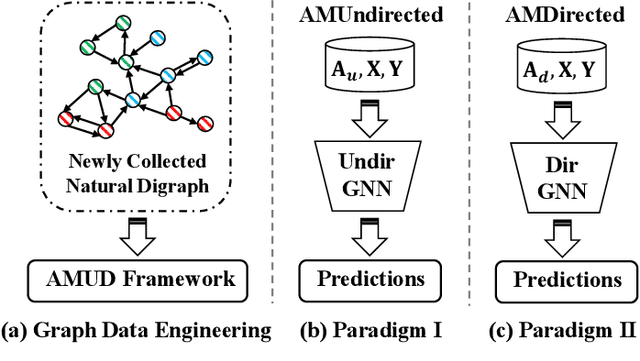

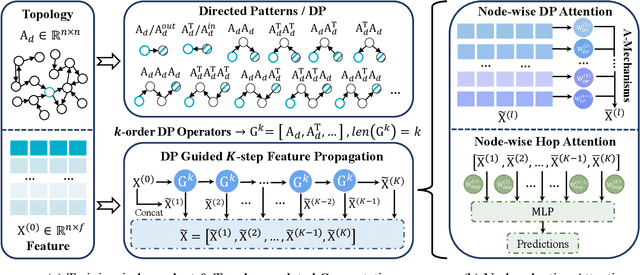
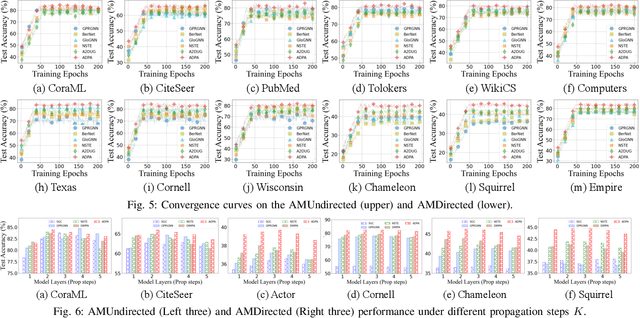
Abstract:Recently, graph neural networks (GNNs) have shown prominent performance in semi-supervised node classification by leveraging knowledge from the graph database. However, most existing GNNs follow the homophily assumption, where connected nodes are more likely to exhibit similar feature distributions and the same labels, and such an assumption has proven to be vulnerable in a growing number of practical applications. As a supplement, heterophily reflects dissimilarity in connected nodes, which has gained significant attention in graph learning. To this end, data engineers aim to develop a powerful GNN model that can ensure performance under both homophily and heterophily. Despite numerous attempts, most existing GNNs struggle to achieve optimal node representations due to the constraints of undirected graphs. The neglect of directed edges results in sub-optimal graph representations, thereby hindering the capacity of GNNs. To address this issue, we introduce AMUD, which quantifies the relationship between node profiles and topology from a statistical perspective, offering valuable insights for \underline{A}daptively \underline{M}odeling the natural directed graphs as the \underline{U}ndirected or \underline{D}irected graph to maximize the benefits from subsequent graph learning. Furthermore, we propose \underline{A}daptive \underline{D}irected \underline{P}attern \underline{A}ggregation (ADPA) as a new directed graph learning paradigm for AMUD. Empirical studies have demonstrated that AMUD guides efficient graph learning. Meanwhile, extensive experiments on 14 benchmark datasets substantiate the impressive performance of ADPA, outperforming baselines by significant margins of 3.96\%.
 Add to Chrome
Add to Chrome Add to Firefox
Add to Firefox Add to Edge
Add to Edge